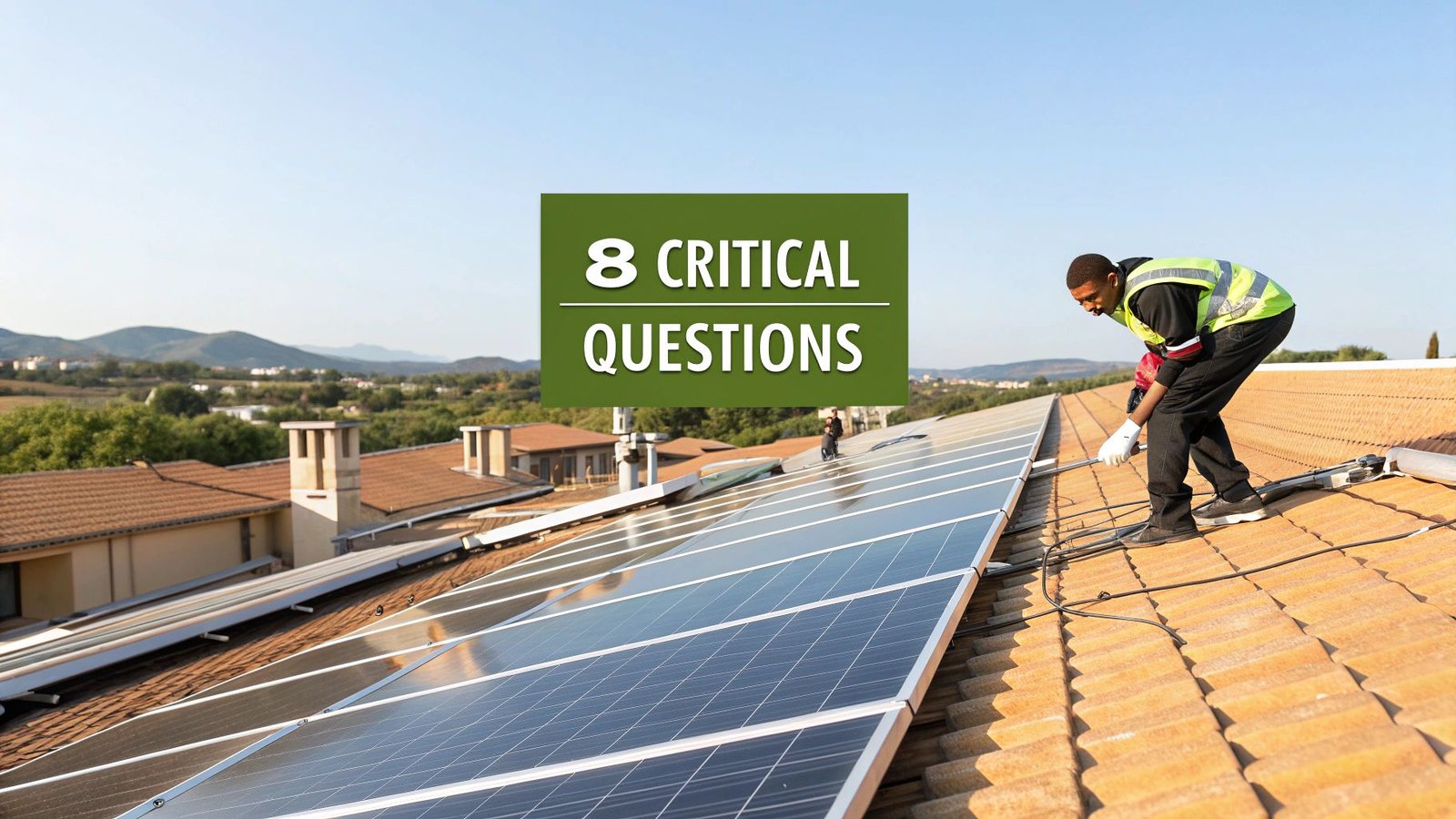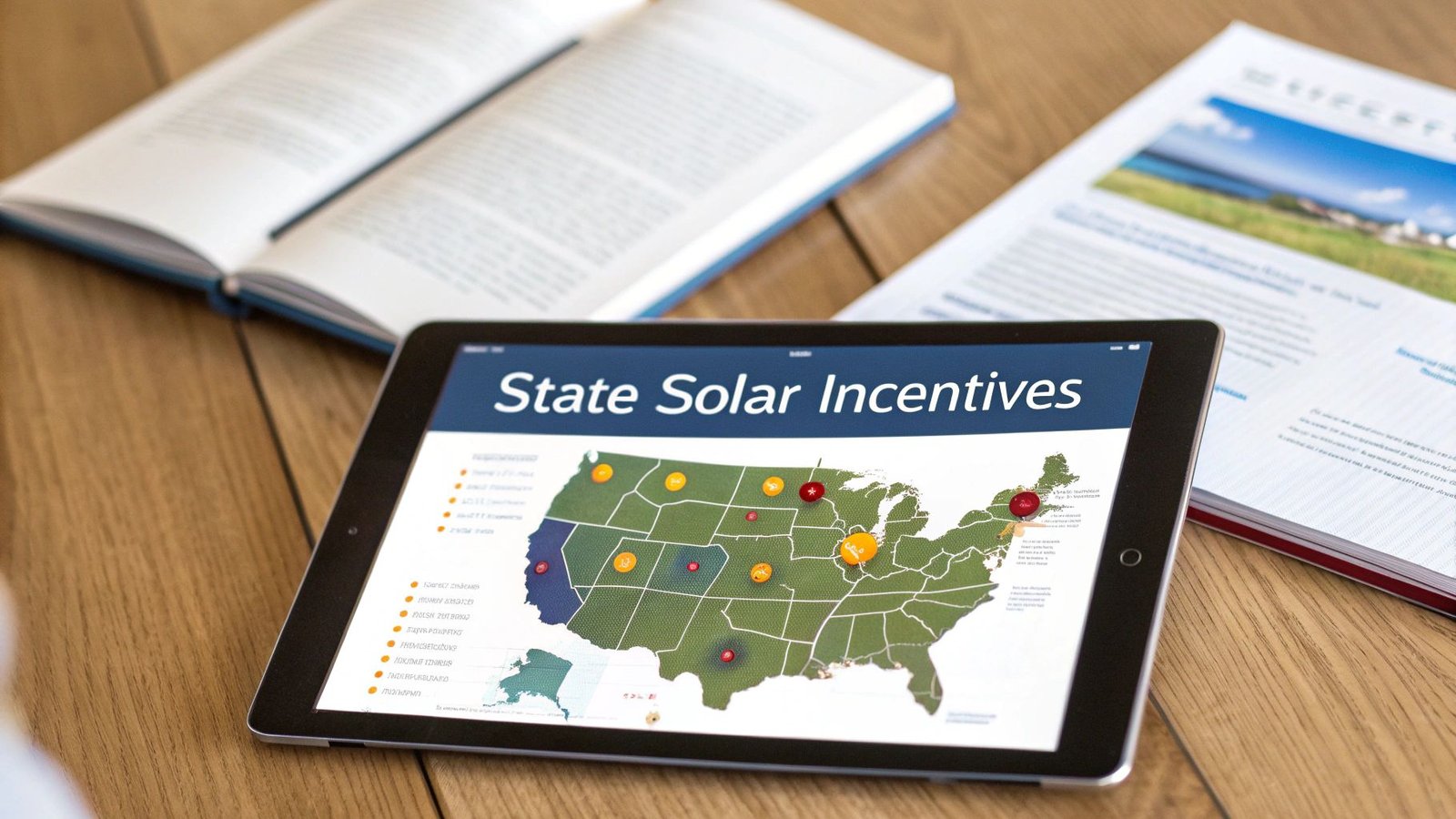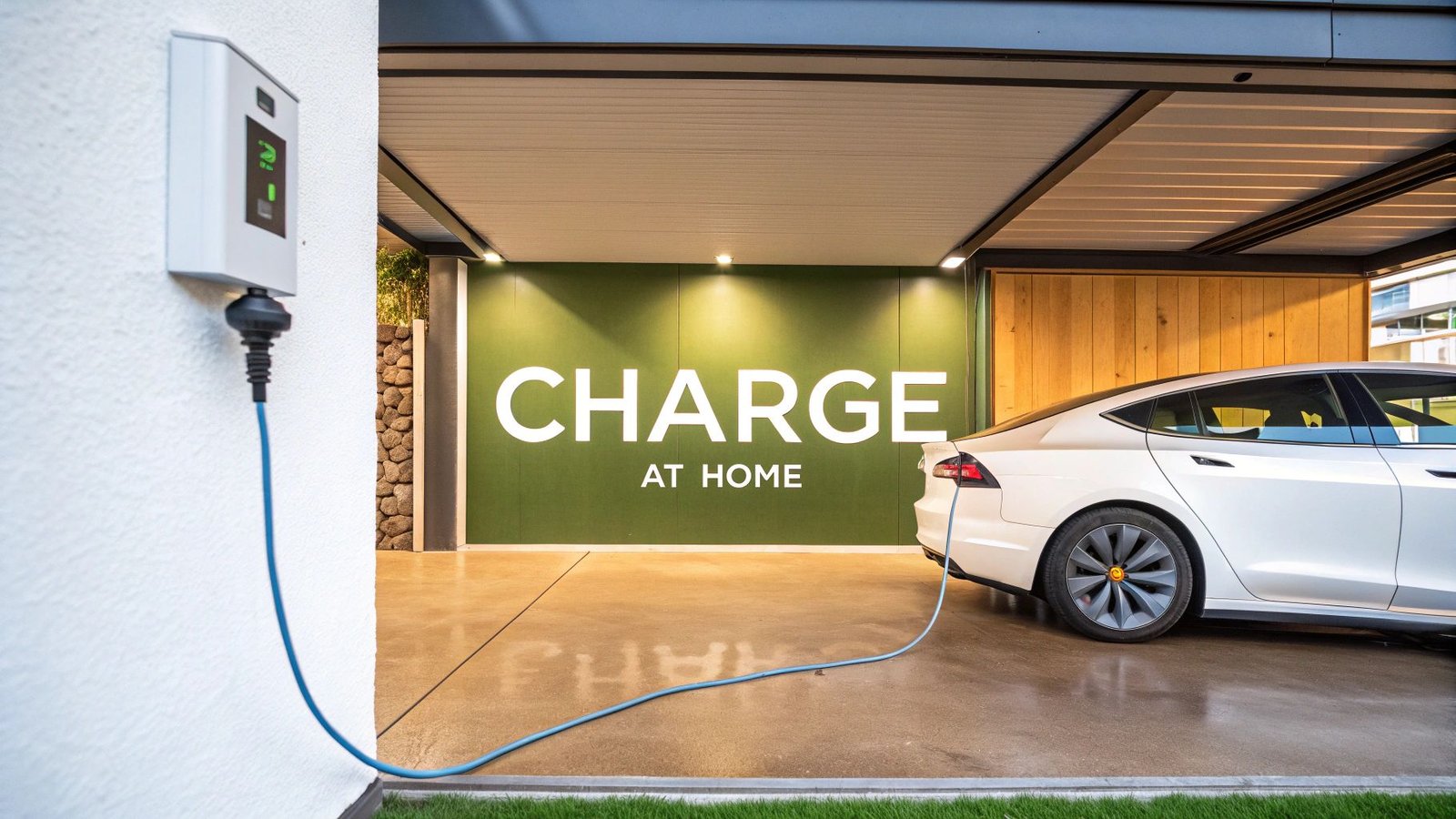So, you're asking, "how big of a solar system do I need?" The core of the answer is a straightforward calculation: take your yearly electricity usage and divide it by the number of peak sun hours your home gets. This will give you a ballpark system size in kilowatts (kW) and is the perfect starting point for your planning.
For most homes across the U.S., this calculation usually points to a system somewhere between 5 kW and 10 kW.
Calculating Your Ideal Solar System Size
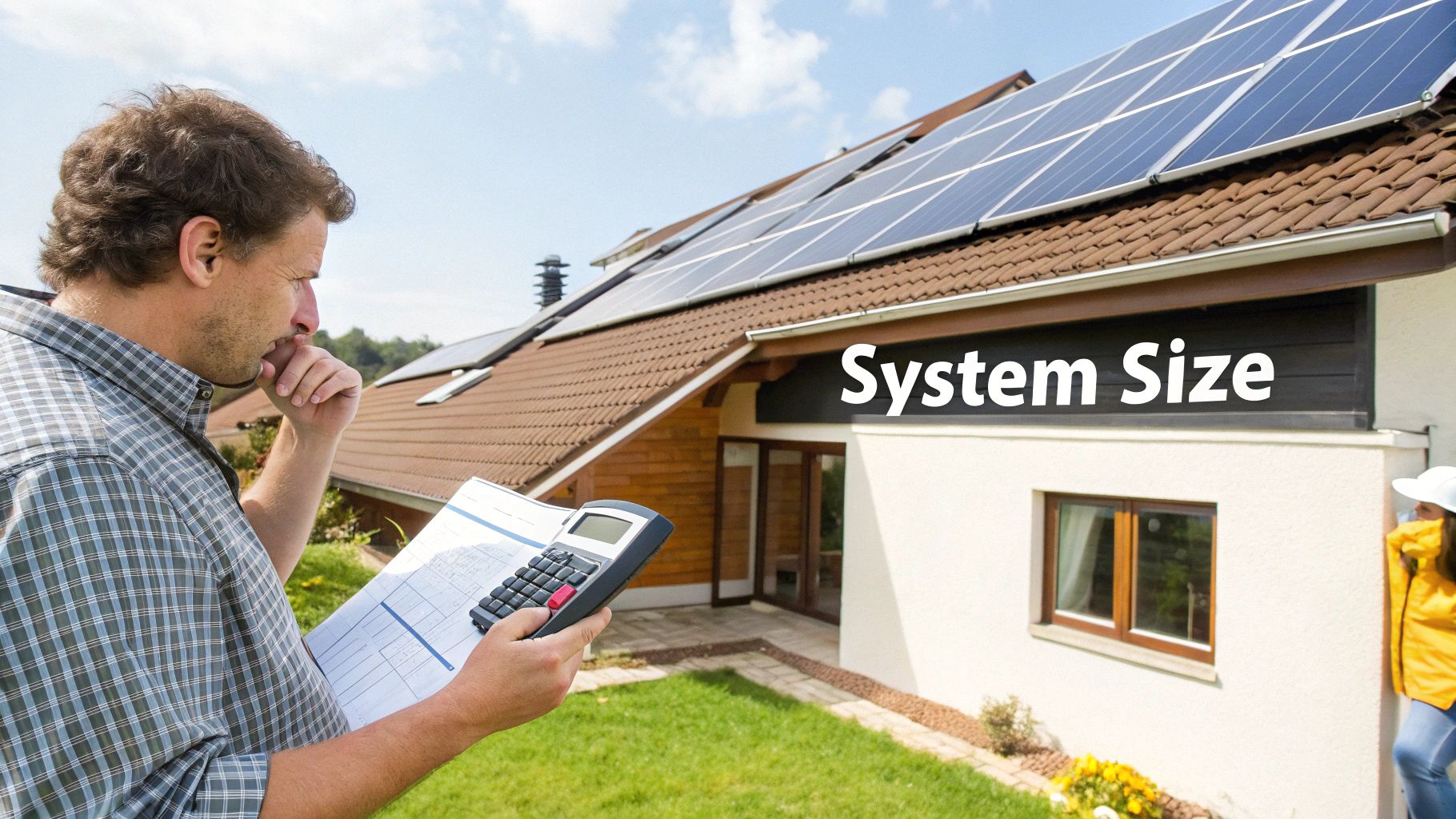
Nailing down the right solar system size is the first real step in going solar. It’s not just about covering your roof in panels; it's about matching your home's unique energy appetite with precision. Getting this right ensures you invest in a system that delivers exactly what you need without paying for capacity you'll never use.
The size of the system you'll need boils down to two main things: how much power your family uses and the amount of solar energy your specific location receives (known as solar insolation).
For example, a 6 kW system in the United States typically takes up about 400 square feet of roof space. This size system is often enough to cover 75–100% of an average American household’s electricity needs, generating roughly 7,000–9,000 kWh per year, depending on local sunshine.
To give you a clearer picture, I've put together a quick reference table. This can help you see where you might land based on your monthly utility bill.
Quick Solar System Size Estimator
| Average Monthly Electric Bill | Estimated Annual kWh Usage | Estimated Solar System Size (kW) |
|---|---|---|
| $50–$100 | 3,600–7,200 kWh | 3–6 kW |
| $100–$150 | 7,200–10,800 kWh | 6–9 kW |
| $150–$200 | 10,800–14,400 kWh | 9–12 kW |
| $200+ | 14,400+ kWh | 12+ kW |
Remember, this table is just an estimate. Your actual usage is the most important number, which we'll get into next.
Your Energy Usage Is the Foundation
The most critical piece of this puzzle is your annual electricity consumption, measured in kilowatt-hours (kWh). You can find this number right on your monthly utility bills, or you can often access it by logging into your provider's online portal.
The best approach is to tally up your usage from the last 12 months. This gives you the most accurate picture of your yearly energy demand, capturing everything from running the AC full-blast in the summer to powering holiday lights in the winter.
Consejo profesional: Don't just look at the yearly total. Pay attention to the monthly trends. Understanding cuando you use the most electricity helps immensely when planning for things like battery storage and ensuring your system can handle your peak demand periods without a hitch.
From Usage to System Size
Once you have your annual kWh usage in hand, the next step is to factor in your area's horas punta de sol. This is a measure of how many hours per day, on average, your location receives sunlight that’s intense enough for your panels to produce at their peak. It varies wildly by region—Phoenix gets a lot more than Seattle.
Dividing your annual kWh by these peak sun hours will give you a solid baseline for the system size you’ll need.
If you want to skip the manual math, our handy solar system sizing calculator can give you a personalized recommendation in minutes. As you plan out your investment, it's also smart to understand the typical periodo de amortización de los paneles solares, which is another key financial piece of the puzzle. This initial math really sets the stage for fine-tuning your plan based on specific panel choices and your long-term goals.
Building Your Home's Energy Profile
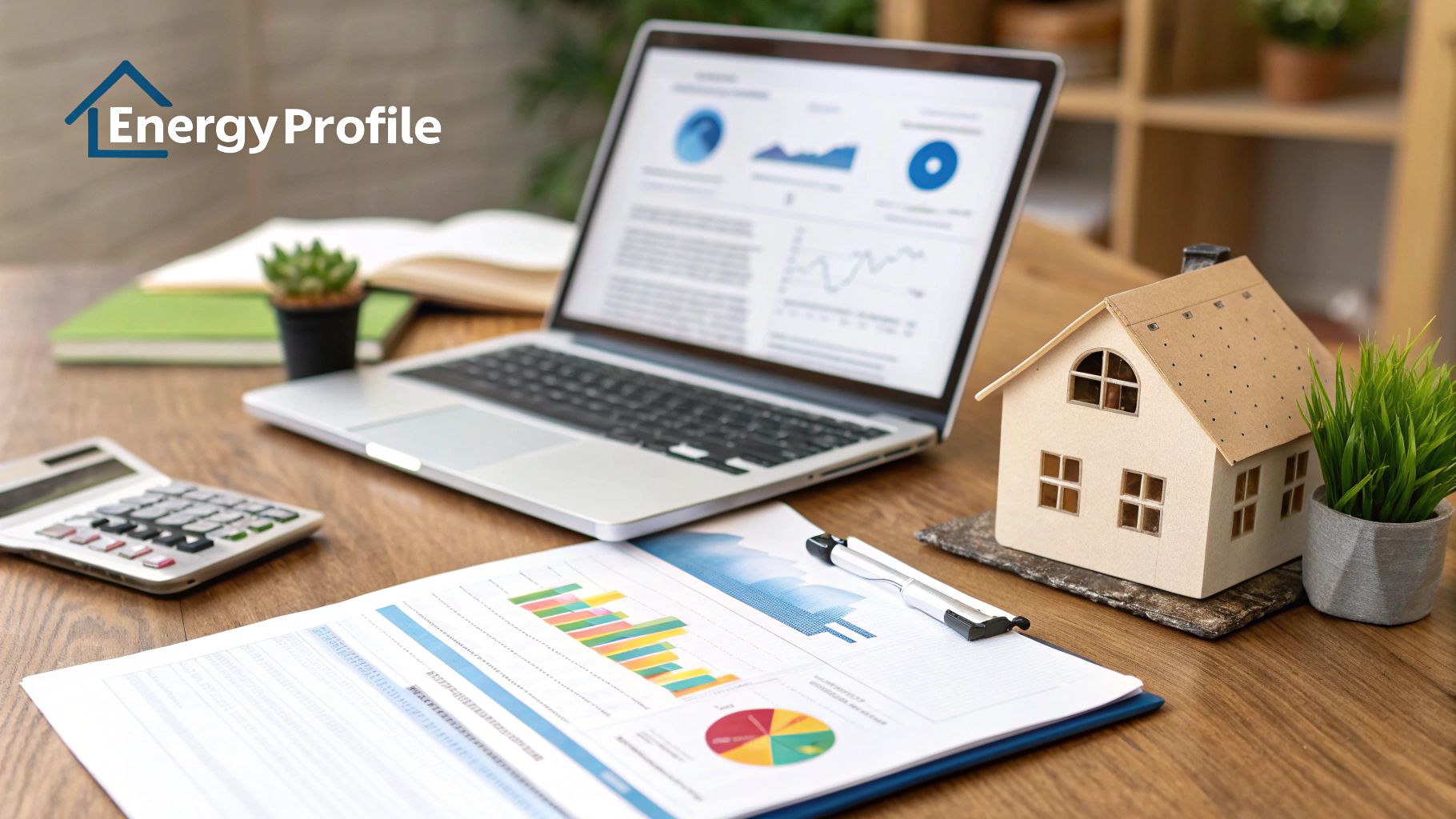
Before you can even think about solar panels, you need a crystal-clear picture of your home’s energy appetite. Your past electricity bills are more than just numbers—they're a detailed story of your power consumption, day in and day out. This history is the single best predictor of your future solar needs.
The first thing you’ll want to do is grab at least 12 meses of your utility statements. Most power companies have online portals that make this easy, letting you download a full year's worth of data in just a few clicks. If you can get your hands on 24 months of data, that's even better, as it helps smooth out any oddball years or unusual weather patterns.
Uncovering Your Annual Kilowatt-Hour Usage
Your mission here is to find the total kilowatt-hours (kWh) your home consumed over a full year. This number is the bedrock for every calculation that comes next. Ignore the dollar amount for a moment; it's the kWh figure that truly matters for sizing a solar system.
Go through each bill and add up the monthly kWh usage to get your annual total.
For example, a family might use a modest 850 kWh in a mild January but then see that number spike to 1,400 kWh in July to keep the air conditioning humming. Adding up all twelve months gives you the complete picture. While a typical American home might land somewhere around 10,600 kWh per year, your number will be as unique as your family.
Lo más importante: Understanding your energy patterns is critical. If you size a system for your lowest-usage month, you'll be stuck buying power from the grid during peak seasons. But if you size it for your highest month, you might end up with an oversized system that isn't cost-effective.
Analyzing Your Home’s Energy Rhythm
With your annual total in hand, it's time to zoom in on the monthly data. You'll probably spot a clear pattern—what I like to call your home’s unique energy rhythm.
- Summer Spikes: See a big jump in usage during the hot months? That’s the classic signature of central air conditioning working overtime.
- Winter Draws: Does your consumption climb when it gets cold? This often points to electric heating, space heaters, or just more time spent indoors with the lights on.
This seasonal insight is pure gold. It helps a solar designer account for those times when you'll need the most power, making sure your system is built to handle the load. To get even more granular, you can learn how to calculate energy consumption for specific appliances in your house.
Planning for Future Energy Needs
Your past usage is a fantastic starting point, but don't forget to look ahead. Are there any big life changes on the horizon that could ramp up your electricity consumption?
- Buying an electric vehicle (EV)
- Adding a hot tub or a swimming pool
- Switching to an electric heat pump for HVAC
- Building a new home addition
An EV alone can easily tack on an extra 2,000 to 4,000 kWh to your annual usage. Factoring these kinds of future loads into your calculations now is smart planning—it prevents you from installing a system that becomes too small in just a year or two.
Finally, before you lock in any numbers, it’s a great idea to give your home a quick energy check-up. Going through a simple home energy audit checklist can pinpoint places where you're wasting power. Sealing up those energy leaks might mean you can get away with a smaller, and therefore less expensive, solar array.
Your Location is Everything: Sunlight, Roofs, and Reality
You can have the best, most efficient solar panels money can buy, but at the end of the day, their output boils down to one simple thing: sunshine. The exact same panel system on a roof in Phoenix will crank out way more electricity than it would in Portland. This is why figuring out your specific "solar potential" is the second most important piece of the puzzle, right after your own energy usage.
It's not just about how sunny your city is in general. We use a specific metric in the industry called horas punta de sol. This isn't just daylight hours; it's a way of measuring the intensity of the sun. Think of it as the number of hours your panels are working at full throttle.
The Bottom Line: Peak sun hours are the standardized way to measure a location's true solar potential. It accounts for weather, seasons, and atmospheric haze, giving you a real-world number to work with.
More peak sun hours mean you can get the job done with a smaller system. Fewer hours mean you'll need a larger one to generate the same amount of power.
A Tale of Two Cities: Peak Sun Hours in Action
The difference across the country is staggering. States in the Southwest, like Arizona and California, might get 6-7 peak sun hours on an average day. Head up to the Northeast or Pacific Northwest, and you could be looking at just 3-4 peak sun hours, especially when you factor in those cloudy winter months.
Let's put this into perspective. Say you've calculated that your home needs about 30 kWh of electricity per day.
- In sunny Phoenix, with an average of 6.5 peak sun hours, you'd need a system of roughly 4.6 kW (30 kWh / 6.5 hours).
- In cloudier Seattle, which gets about 3.8 peak sun hours, you'd need a much beefier 7.9 kW system to generate that same 30 kWh (30 kWh / 3.8 hours).
That’s not a small difference. It directly impacts the cost of your system and how much roof space you’ll need.
This chart makes it crystal clear: the system your cousin got in Miami is probably not the right one for your home in Chicago. Solar is never a one-size-fits-all solution.
It's Not Just the Sun—Your Roof Plays a Huge Role
Peak sun hours give us the big picture, but we have to zoom in on your actual roof to get the final, accurate numbers. A few real-world factors can make or break your system's performance.
-
Roof Direction: In the U.S., a south-facing roof is the holy grail for solar. It gets the most direct sun all day long. Don't have one? Don't worry. East and west-facing roofs are perfectly fine, though they might be about 15-20% less productive. You just might need an extra panel or two to make up the difference.
-
Roof Angle: The ideal pitch of your panels often matches your latitude, but honestly, this isn't something most homeowners need to sweat. Installers are experts at working with your existing roofline to get the best possible production.
-
Shade: This is the silent killer of solar production. That beautiful old oak tree, your neighbor’s two-story addition, or even your own chimney can cast shadows that slash your system's output. Any good installer will perform a thorough shading analysis to map out the sunniest spots on your roof and avoid the dead zones.
Choosing the Right Solar Components
Alright, once you've got a solid handle on your energy usage and how much sun your home gets, it's time to dive into the fun part: the hardware. Choosing your gear isn't just about picking what looks good; the equipment directly dictates how big your solar system needs to be to hit your energy goals.
Think of it as a balancing act between performance, budget, and the space you're working with.
For instance, high-efficiency panels can crank out more power from a smaller area. This is a game-changer for anyone with a small roof or a few pesky trees casting shadows. Opting for premium gear might mean you can install a physically smaller array that still generates all the electricity you need.
Solar Panels: The Foundation of Your System
The first and most fundamental choice is the solar panel itself. For most homes, it boils down to two main technologies: monocrystalline and polycrystalline. They might look similar from a distance, but they have some key differences.
-
Monocrystalline Panels: These are the sleek, black panels you often see. They're made from a single, pure silicon crystal, which makes them the most efficient option out there. They squeeze more electricity out of every square foot, making them perfect if you have limited roof space.
-
Polycrystalline Panels: You can spot these by their distinct blue, speckled look. They're made by melting multiple silicon fragments together. While they're a bit less efficient than their monocrystalline cousins, they’re also easier on the wallet. This makes them a fantastic value for homeowners with plenty of sunny, open roof space.
Ultimately, the decision often comes down to efficiency versus cost. The following chart illustrates this trade-off.
| Tipo de panel | Eficacia | Coste | Best For… |
|---|---|---|---|
| Monocristalino | 18% – 24% | Más alto | Limited roof space, maximizing power output |
| Policristalino | 15% – 20% | Baja | Large roof areas, budget-conscious projects |
If you've got a big, wide-open roof, polycrystalline panels can be a smart way to lower your upfront investment. But if you need to maximize every last inch to meet your energy demands, the superior performance of monocrystalline panels is usually worth the extra money.
This infographic really helps visualize how all the environmental factors come into play and influence your hardware choices.

As you can see, your location, local weather, and roof layout create a unique solar profile. The right components are the ones that work best within that specific profile.
Inverters: The Brains of the Operation
Don't overlook the inverter. It's just as critical as the panels. This device is what converts the direct current (DC) electricity your panels generate into the alternating current (AC) that your appliances and electronics actually use.
Información clave: Your choice of inverter has a massive impact on your system's performance, especially if you have a tricky roof with intermittent shade. It's a critical decision that affects not just your energy output but also your ability to monitor how things are working.
There are three main types of inverters you’ll come across:
-
Inversores de cadenas: This is the old-school, tried-and-true option. It's cost-effective and works by linking several panels together in a "string," which then feeds into one central inverter. The catch? If one panel's output drops because of a shadow or some leaves, the entire string's production gets dragged down with it.
-
Microinversores: These are a more modern solution where a small inverter is installed on the back of every single panel. This lets each panel work independently, maximizing production. They cost more upfront but are hands-down the best choice for complicated roofs or places with shading issues.
-
Optimizadores de potencia: This is a clever hybrid approach. You get small "optimizers" on each panel that condition the DC power before sending it to a central string inverter. This gives you many of the panel-level benefits of microinverters, but usually at a slightly lower price point.
Factoring in Batteries and Grid Connection
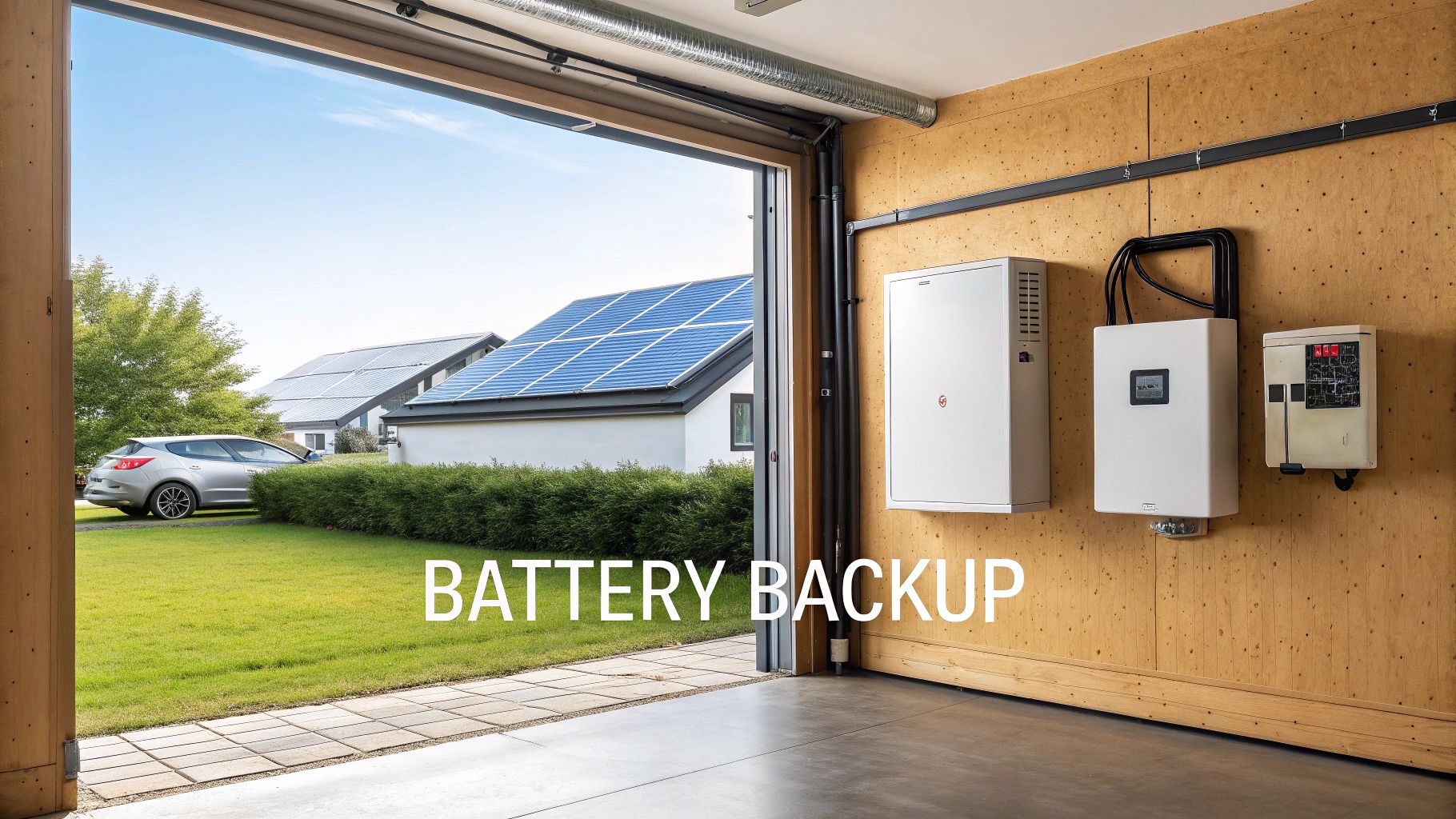
Modern solar systems are about more than just generating power when the sun is shining; they're about giving you real control over your energy. A huge part of that control comes from deciding whether or not to add battery storage. This one decision completely changes the conversation around how big of a solar system you actually need.
Adding batteries takes you from simply lowering your utility bill to achieving genuine energy resilience. You gain the ability to keep the lights on during a blackout, power your home with your own solar energy at night, and sidestep those punishingly high electricity rates during peak hours.
Do You Need a Solar Battery?
The answer really comes down to what you want to achieve with your system. For some homeowners, the peace of mind that comes with backup power is the main driver. For others, it’s about squeezing every last drop of value out of their investment by using every kilowatt-hour their panels produce.
Here's a straightforward way to look at it:
- You'll likely want a battery if: Your area is prone to power outages or your utility company uses Time-of-Use rates that make evening electricity super expensive.
- You might be fine without a battery if: Your local utility has a solid net metering program, and your main goal is simply to offset your monthly electricity costs.
The size of your battery, which is measured in kilowatt-hours (kWh), depends entirely on what you want to keep running when the grid goes down. Powering essentials like your refrigerator and a few lights requires a much smaller, more affordable battery than one sized to run your entire house. We dive deeper into sizing your storage in our guide on how to store solar energy.
Grid-Tied vs. Off-Grid
The other half of the puzzle is your relationship with the utility grid. The vast majority of home solar installations are grid-tied, which means you stay connected. This setup is incredibly flexible, allowing you to pull power from the utility when your panels aren't producing and, just as importantly, send your excess solar power back to the grid.
Lo más importante: A grid-tied system paired with a good net metering policy is a game-changer. It lets you earn credits for the extra power your panels generate, which can dramatically reduce the size of the solar array you need to buy. In this scenario, the grid basically acts like a massive, free battery for you.
Going completely off-grid is a whole different ballgame. It's the ultimate path to energy independence, but it demands a much larger solar array and a beefy battery bank to carry you through strings of cloudy days or long winter nights. It’s absolutely achievable but comes with a significantly higher upfront cost and requires you to be much more mindful of your day-to-day energy use.
For perspective, the scale of residential solar is worlds away from massive utility projects. As of August 2023, the U.S. had about 156 GW of utility-scale solar capacity, with projects often needing 5–10 acres for a single megawatt. Your home system, on the other hand, is designed for self-sufficiency on a tiny fraction of that footprint. Ultimately, deciding whether to stay connected or cut the cord is crucial for sizing your system for affordability and practicality.
Answering Your Top Solar Sizing Questions
Once you’ve run the numbers, you're bound to have some lingering "what if" questions. That's a good thing. Thinking through these common scenarios is what separates a decent plan from a great one, and it can save you a lot of money and frustration down the road.
Let's walk through some of the most common questions I hear from homeowners trying to nail down their perfect system size.
What Happens If I Go Too Big With My Solar System?
It’s tempting to think "more is better" when it comes to solar panels. Why not build a system that generates way more power than you need? The answer really comes down to one thing: your local utility’s net metering policy.
Some utility companies are fantastic and give you full credit for every extra watt you send back to the grid. In that case, oversizing can be a smart investment, banking credits for cloudy days or winter months.
However, many others offer pennies on the dollar for your excess power, or they might cap how much they'll credit you for. Before you even think about intentionally oversizing, you absolutely have to get the specifics on your utility’s rules. Otherwise, you could spend thousands on extra panels that give you a terrible return on your investment.
Should I Really Aim to Cover 100% of My Electric Bill?
Getting a 100% energy offset is a common goal—and a great one if it fits your situation. Wiping out your electric bill feels fantastic and delivers the biggest long-term savings. But it's not always the right move for everyone. A system that large demands the biggest upfront investment and, of course, the most roof space.
Honestly, a system covering 50-80% of your electricity needs can still make a massive dent in your monthly expenses. This smaller-scale approach often has a faster payback period, which makes it a much more practical entry point into solar for a lot of families.
Your solar journey is unique. Don't feel pressured to aim for a 100% offset if a smaller, more affordable system meets your primary goal of lowering energy costs.
How Does Buying an EV Affect My Solar Panel Needs?
This is a big one. Bringing an electric vehicle home will dramatically increase your electricity usage, and you need to plan for it. Depending on how much you drive, a new EV can easily add 2,000 to 4,000 kWh to your yearly power consumption.
So, how do you account for it? You need to estimate how much electricity your car will use over a year. A straightforward way to do this is to take your expected annual mileage and divide it by the car's efficiency rating (usually in miles per kWh).
Here’s a real-world example:
- You drive about 12,000 miles per year.
- Your new EV gets around 3 miles/kWh.
- That means you’ll need an extra 4,000 kWh of power annually (12,000 ÷ 3 = 4,000).
Make sure you add that number to your home's total usage antes de you calculate your final system size. It's a critical step to ensure your system can handle both your home and your new ride.
Ready to take the next step and get a system designed for your unique needs? At Energía radiante, we provide high-quality solar energy solutions for homes and businesses. Let us help you design the perfect system for your energy goals. Get your personalized solar quote today!


